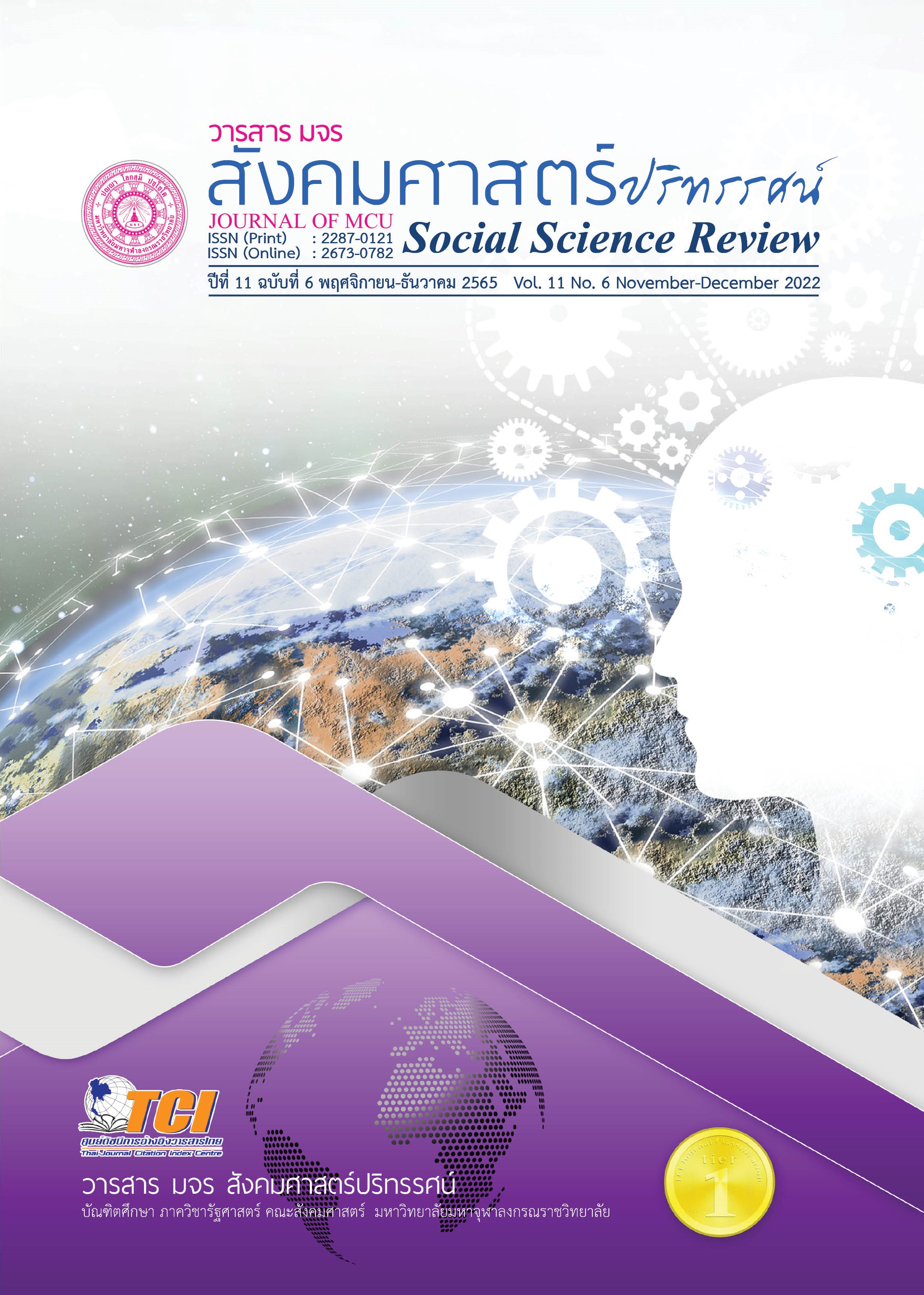APPLICATION OF DESIGN THINKING IN PUBLIC POLICY PROCESS
Keywords:
Social cognitive theory, Flood disaster preparedness behavior, Civil defense volunteersAbstract
Design thinking is a creative problem-solving thinking. Flood disaster in Thailand is likely to become more severe. Although the government parts have ongoing measures to manage water crisis continuously. Still, the flood problems have effects in many dimensions, physically, socially and economically. Therefore, prevention to mitigate the impact of floods requires preparedness behaviors of individuals to reduce the severity of the impacts of flood disaster. Disaster preparedness is the development of the potential of individuals, especially civil defense volunteers, who have roles to take care of themselves and other people, who must be developed preparedness behaviors. This article aimed to present the flood disaster preparedness behavior by applying social cognitive theory to develop preparedness behavior in civil defense volunteers consisted of self-efficacy preparedness, risk perception disaster, disaster experience including the application of social cognitive theory to develop civil defense volunteers flood disaster preparedness behavior. The article suggested the developing preparedness behavior for relevant agencies to use as guideline for preparing for flood disasters for civil defense volunteers.
References
กรมป้องกันและบรรเทาสาธารณภัย (2559). การลดความเสี่ยงจากภัยพิบัติ (ฉบับที่3). กรุงเทพฯ: สมาคมสหกรณ์การเกษตรแห่งประเทศไทย.
______. (2559). แผนยุทธศาสตร์กรมป้องกันและบรรเทาสาธารณภัย พ.ศ. 2560-2564กรุงเทพฯ: สมาคมสหกรณ์การเกษตรแห่งประเทศไทย.
______. (2561). รายงานการแจ้งเตือนภัยพิบัติ. สืบค้น 20 พฤศจิกายน 2564, จาก https://www.thairath.co.th/news/local/northeast/1955605.
กรุงเทพธุรกิจ. (2564). แม่สลองใน จ.เชียงราย น้ำท่วมฉับพลัน ชาวบ้านปีนหลังคาหนีน้ำ. สืบค้น 20 พฤศจิกายน 2564, จาก Https://www.bangkokbiznews.com
ทวิดา กมลเวชช. (2554). คู่มือการจัดการภัยพิบัติท้องถิ่น. กรุงเทพฯ: สถาบันพระปกเกล้า.
ไทยรัฐออนไลน์. (2564). น้ำท่วมโคราช น้ำจากเขาใหญ่ไหลท่วมปากช่องซ้ำรอบ 2 ระดับน้ำเพิ่มเรื่อย ๆ. สืบค้น 20 พฤศจิกายน 2564, จาก https://shorturl.asia/A5rHI.
สมโภชน์ เอี่ยมสุภาษิต. (2556). ทฤษฎีและเทคนิคการปรับพฤติกรรม (พิมพ์ครั้งที่ 8). กรุงเทพฯ: สำนักพิมพ์แห่งจุฬาลงกรณ์มหาวิทยาลัย.
Allender, J. A., et al. (2010). Community Health Nursing Promoting & Protecting the Public’s Health (7th ed.). China: Lippincott Williams & Wilkins Health.
Bandura, A. (1986). Social foundations of thought and action: a social cognitive theory. Englewood Cliffs, N.J.: Englewood Cliffs, N.J.: Prentice-Hall.
Becker, J. S., et al. (2013). Salient beliefs about earthquake hazards and household preparedness. Risk Analysis, 33(9), 1710-1727.
Bubeck, P., et al. (2013). Detailed insights into the influence of flood-coping appraisals on mitigation behaviour. Global environmental change: human and policy dimensions, 23(5), 1327-1338.
Coppola, D. P. (2011). Introduction to International Disaster Management (2nd ed.). Oxford: Butterworth-Heinemann.
Coulston, J. E., & Deeny, P. (2012). Prior Exposure to Major Flooding Increases Individual Preparedness in High-Risk Populations. Prehospital and disaster medicine, 25(4), 289-295.
Dillon, R. L., et al. (2014). Near-misses and future disaster preparedness. Risk Analysis, 34(10), 1906-1922.
Duggan, S., et al. (2010). Perceptions of older people on disaster response and preparedness. International Journal of Older People Nursing, 5(1), 71-76.
Espina, E. (2015). A Social Cognitive Approach to Disaster Preparedness. Philippine Journal of Psychology, 48(2), 161-174.
Glendon, A. I. (2006). Human Safety and Risk Management (Second Edition). Hoboken: Hoboken CRC Press.
Hoffmann, R. & Muttarak, R. (2017). Learn from the Past, Prepare for the Future: Impacts of Education and Experience on Disaster Preparedness in the Philippines and Thailand. World Development, 96(C), 32-51.
Kolb, D. A., & Fry, R. (1975). Towards an applied theory of experiential learning Theories of Group Process (Cooper Ed.). London: John Wiley.
Kron, W. (2015). Flood disasters - a global perspective. Water Policy, 17(S1), 6-24.
Lawrence, J. et al. (2014). Integrating the effects of flood experience on risk perception with responses to changing climate risk. Mitigation of Natural Hazards, 74(3), 1773-1794.
Ohman, S. (2017). Previous Experiences and Risk Perception: The Role of Transference. Journal of Education Society and Behavioural Science, 23(1), 1-10.
Paton, D., et al. (2005). When good intentions turn bad: promoting natural hazard preparedness. Australian Journal of Emergency Management, 20(1), 25-30.
Perry, R.W., & Lindell, M. K. (2008). Volcanic risk perception and adjustment in a multi-hazard environment. Journal of Volcanology and Geothermal Research, 172(3), 170-178.
Rerngnirunsathit, P. (2012). Thailand Country profiles 2011. Retrieved November 20, 2021, from https://www.adrc.asia/latest_disaster.php
Schmidlin, T. W. (2014). Risk Factors and Social Vulnerability. Kent State USA.
Simons-Morton, B., et al. (2012). Behavior theory in health promotion practice and research. Mass: Jones & Bartlett Learning Sudbury.
Spencer, T. (2016). Risk Perception: Theories and Approaches. New York: Nova Science Publishers.
Takao, K., et al. (2011). Factors determining residents’ preparedness for floods in modern megalopolises: the case of the Tokai flood disaster in Japan. Journal of Risk Research, 7(7-8), 775-787.
Thomas, T., et al. (2015). Influences of Preparedness Knowledge and Beliefs on Household Disaster Preparedness. MMWR. Morbidity and Mortality Weekly Report, 64(35), 965-971.
Worldbank. (2012). Note 2–2 Disaster Management Plans. Knowledge Notes, Cluster 2. Nonstructural Measures. Retrieved November 20, 2021 from https://www.preventionweb.net/files/29163_drmkn221.pdf
Downloads
Published
How to Cite
Issue
Section
License
Copyright (c) 2022 Journal of MCU Social Science Review

This work is licensed under a Creative Commons Attribution-NonCommercial-NoDerivatives 4.0 International License.
In order to conform the copyright law, all article authors must sign the consignment agreement to transfer the copyright to the Journal including the finally revised original articles. Besides, the article authors must declare that the articles will be printed in only the Journal of MCU Journal of Social Sciences. If there are pictures, tables or contents that were printed before, the article authors must receive permission from the authors in writing and show the evidence to the editor before the article is printed. If it does not conform to the set criteria, the editor will remove the article from the Journal without any exceptions.





